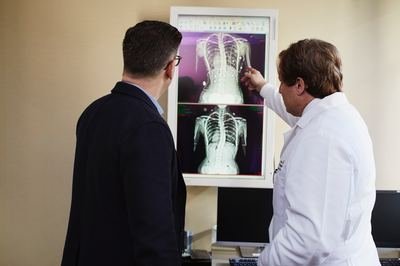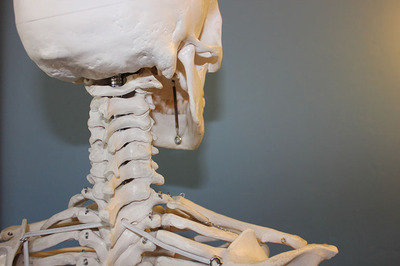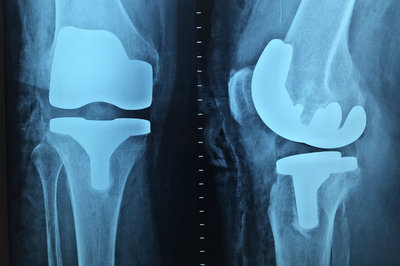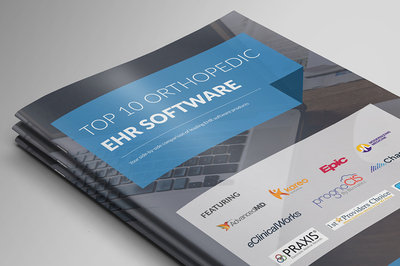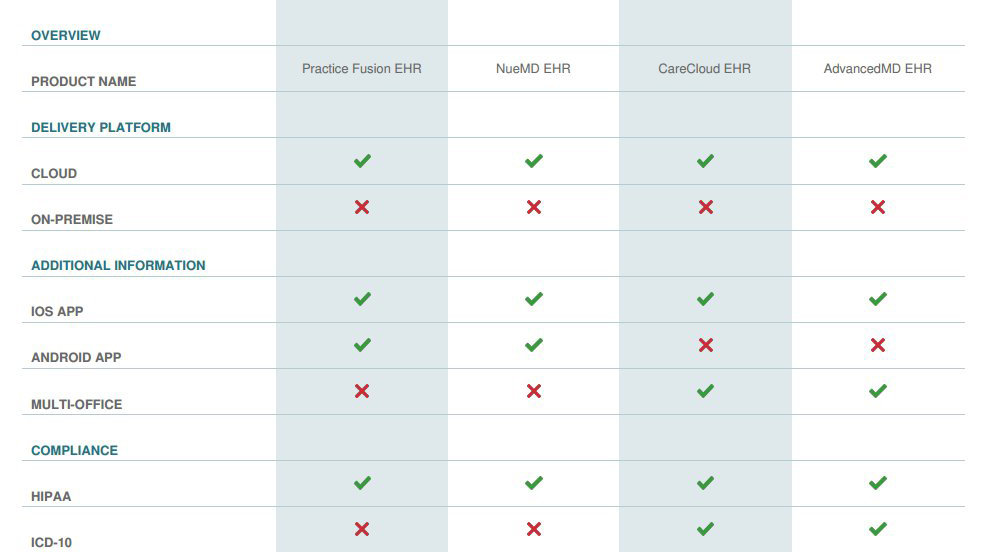Orthopedic EHR Buyers’ Guide
Orthopedic practices have a difficult task when selecting an EHR given the wide scope of conditions they treat, and the high volume in which they treat patients. Selecting an orthopedics EHR follows the same approach used to select another type of EHR. An effective selection process relies on information gathering to establish a selection criterion that incorporates input from all stakeholders in a practice to generate a list of EHR features that best contribute to a practice’s goals.
However, given the demanding nature of the conditions orthopedic practitioners work in, there are several specialty EHRs available for this discipline, so orthopedic practices possess a great deal more freedom than other specialties to select an EHR that meets the needs of their practice. Orthopedic practices are not bound to modifying a general EHR to their specialty - rather they can select one of the many EHRs on the market that are tailor-made to orthopedic practices.
Regarding orthopedic EHRs, one of the primary considerations selection teams will face when choosing involves the manner in which orthopedic clinical is inputted and structured in an EHR system. Secondly, selection teams in orthopedic practices must also consider how their EHR can enhance operations in their practice by providing features that allow for more effective billing and the ability to monitor financial performance.
Given the realities of orthopedic practices, what do these practices require from an EHR and how can EHR meet these needs? This guide will help establish:
- What requirements orthopedic EHR should meet, and which features you should consider
- How much orthopedic EHR costs
- Which orthopedic EHR vendors you should consider
Which orthopedic EHR features do you need to meet your requirements?
Orthopedic practices are presented with a wide variety of clinical data to collect and record, so an EHR must equip a practice to deal with high patient volumes, manage care across different settings and manage the risk associated with prescribing narcotic painkillers.
EHR features that will help meet these requirements include:
Flexible workflows and data entry
What an orthopedic practice will need can vary depending on whether specialty orthopedic services are being offered or the practices patient-base is unique. The field of orthopedics involves a wide variety of practice areas from sports medicine, treating workplace injuries, physical therapy, and orthopedic surgery. As such an orthopedics EHR should, at a minimum offer, flexibility in, how workflows and data entry processes including orthopedic EMR templates.
Intuitive design
Orthopedic practices notoriously have a higher patient volume when compared to other specialty practices. As such, an orthopedic EHR must be designed with features that create efficient workflows to avoid backlogs in patients and be able to offer practice management features that can manage scheduling and other patient engagement areas. Further, orthopedic practices handling high volumes of patients must be able to maintain their quality of care, given that they spend less time with patients compared to other practices. An orthopedic EHR’s entire design should be centered around this.
Care management
When a patient presents to an orthopedic practice, they are also likely under the care of other providers and will require long-term care management. As such, orthopedic practices must be able to share records and monitor a patient’s progress over a period of time and across multiple care settings.
E-prescription of controlled substances
Orthopedic practices like any other practice that treats patients experiencing chronic or acute pain must prescribe addictive prescription painkillers as part of their treatment. Accordingly, clinics that prescribe painkillers are often the target of patients seeking painkillers to feed an addiction or to divert for sale on the streets.
Orthopedic practices must therefore be able to monitor a patient’s history to identify cases of substance abuse, prevent “doctor-shopping” for painkillers and to comply with relevant state and federal regulations regarding painkiller prescriptions. A good e-prescribing module, with functionality for safely prescribing controlled substances, is therefore essential in ensuring orthopedic practices remain compliant with industry regulations in this area.
For more ideas, check out our guide to 50 features to look for in your next EHR purchase
Orthopedics specific templates for notes
Clinical data collected by orthopedic clinicians will require specific data fields to accommodate the type of data generated in the process of treating patients receiving orthopedic care. As such the EHR selected should contain orthopedics specific templates that reflect the wide range of clinical data orthopedic practices will collect and use.
Customizable templates for clinical data
In addition to offering orthopedic-specific templates, an orthopedic EHR should also offer customizable content that allows clinicians the ability to tailor workflows to meet a range of needs. Not every practice will have the same needs regarding how data entry will be conducted. Therefore, it is important that practice can customize templates for entering clinical data so workflows can be made to best optimize how clinicians enter data and interact with their EHR.
Customizable treatment plans
Orthopedic treatment plans should be customizable to allow them to fit into existing workflows or make workflows more efficient without extensive customization and content development to be aligned with how orthopedic practices work daily. For example, some orthopedic EHRs contains a knowledge base that enables the creation of customizable “one-click” treatment plans, orders for surgery and therapy, prescriptions, patient education, and referral letters, and much more.
Practice management
According to the most recent American Association of Orthopedic Executives Benchmarking Survey when surveyed about pressing issues facing their practices, the most significant concern expressed was managing overhead expenses including employee salaries, facility, medical, office, and other expenses - not directly allocated to physicians. Practice management software can help alleviate some of the headaches associated with handling overhead costs and the overall management of a practice’s financial operations. Ideally, a practice management system should be integrated with the orthopedic EHR to provide seamless and comprehensive practice management.
In addition, the survey mentioned above also noted concerns regarding making billing and collections operations more efficient. When considering a practice management system integrated with an orthopedic EHR it is important to make sure billing and collections management features are included. With the inclusion of these features, orthopedic practices can make their billing and collections operations more efficient by providing the ability to track and automate revenue generation.
The features outlined above should be viewed as a comprehensive checklist of what orthopedic software EHR should offer if it is going to be used in a manner that contributes to both clinical quality improvement and greater efficiency in delivering care.
How much does orthopedic EHR cost?
Just like any other EHR product, the cost of an orthopedics EHR varies based on functionality, method of deployment, and vendor implementation fees. As well as the out-of-box price, you should consider:
- Number of modules
- Updating hardware (if opting for an on-premise system)
- Implementation costs (consultancy, training, customization)
- Staff overtime during implementation
- Reduced patient throughput during implementation
- Maintenance agreements and vendor support packages
A Health Affairs study found that a typical multi-physician practice would spend about $162,000 to implement an EHR, with $85,500 for first-year maintenance costs. This will vary from practice to practice but is a good starting point for a budget calculation.
While initial fees will vary from vendor to vendor, here are a few examples of base-level pricing from vendors who sell into the orthopedic EHR market. For more, download our comprehensive EHR pricing guide.
- TotalMD: $3999 per user (perpetual license)
- eClinicalWorks: $449 per provider per month
- AdvancedMD: $720 per provider per month
- Kareo EHR: $300 per provider per month
- CureMD: $295 per provider per month
Which orthopedics EHR vendors should you consider?
The following is a list of four of the best EHRs for orthopedic practices. While you'll need to carry out your own requirements gathering exercise and shortlist vendors accordingly, these are a solid starting point.
Phoenix Ortho EMR
Phoenix’s Ortho EMR is sold on a standalone basis and also offers integrated PACS and practice management software.
The system allows for point and click, voice dictation, or traditional transcription and interfaces well with digital x-rays and MRIs by using an industry-first integrated imaging solution which attaches images (x-rays, MRIs, and ultrasound studies) to the patient chart. This eliminates the need for image order, storage, and review while eliminating data entry and manual order entry by technicians.
The workflow in the product is highly intuitive - it adapts to physician preferences, and does not require templates, which given the high patient volume most orthopedics practices encounter, offers a welcome time saver.
Exscribe Orthopedic EHR
Exscribe’s cloud-based orthopedic software is one of the best-reviewed EHR for orthopedics on the market today. Exscribe offers a sophisticated practice management and PACS solutions alongside the EHR, and also offers mobile device compatibility through a native iOS app.
Users benefit from e-prescribing and a patient portal, which allows the patient to access health data easily without the need for medical paperwork. One of the value points in this system rests in its ability to optimize workflows without extensive customization and development. To achieve these efficiency gains, Exscribe offers a knowledge base that enables the creation of customizable one-click treatment plans, orders for surgery and therapy, prescriptions, patient education and referral letters.
The solution offers a great deal of flexibility in workflow and data entry preferences, allowing multiple providers to work seamlessly with the system.
Modernizing Medicine's Orthopedic EHR
Modernizing Medicine's Orthopedic EMR is a cloud-based, mobile-friendly system offering a standard suite of EHR features with practice management, revenue cycle management, and telehealth functionality. The system offers a touch-based interface and allows the ability to automate forms, billing information, generate patient education and e-Prescribe.
Modernizing Medicine’s product draws heavy inspiration from the interfaces used in other mobile operating systems. The product’s Electronic Medical Assistant (EMA) is able to enhance workflows by adapting to clinician preferences and facilitates clinical collaboration within an organization.
One of the unique features in this system is its ability to provide practices with a MIPS scorecard, real-time peer benchmarking, and automated reporting, allowing providers to track their performance under the newly implemented merit-based reimbursement program through CMS.
ChartLogic for Orthopedics
ChartLogic’s cloud-based EHR solution for orthopedic practices offers a full suite of EHR features including practice management, medical billing services, e-prescribing and a patient portal.
The system also features orthopedic EMR templates and flow sheets which allow for customizable content and the ability to tailor workflows accordingly. Most important to time-pressed clinicians ChartLogic boasts that its system allows for the creation of patient notes in less than 90 seconds by eliminating extraneous clicking and pull-down boxes by featuring a complete patient note on a single screen.













